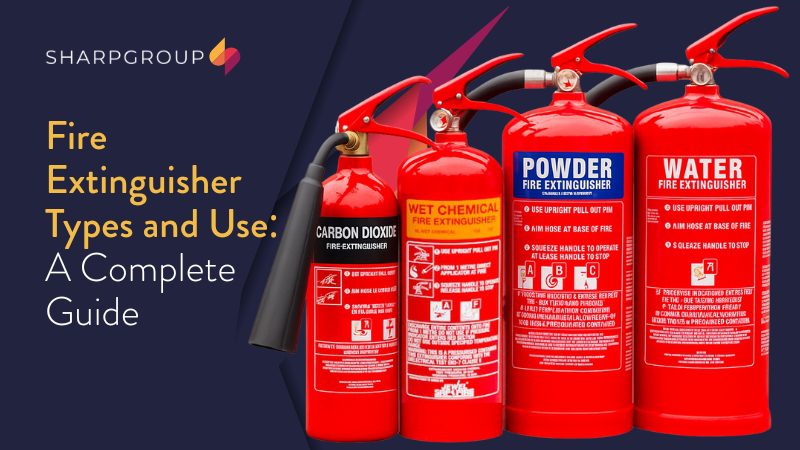
Knowing the different fire extinguisher types is essential for any effective fire safety plan. They ensure businesses and organisations are prepared for emergencies. Understanding the different types of fire extinguishers, their uses, and placement is crucial. Knowing the correct way to operate them can significantly reduce damage and enhance safety.
As a trusted provider of Fire & Security Services, Sharp Group offers guidance to help businesses protect their premises. This guide provides a comprehensive overview for workplaces, public buildings, and other premises.
Understanding Fire Extinguisher Types
Different fire extinguisher types are designed for specific kinds of fires. Using the wrong type can be dangerous, so it is crucial to understand what each extinguisher is suitable for.
1. Water Fire Extinguishers (Including Additive Models)
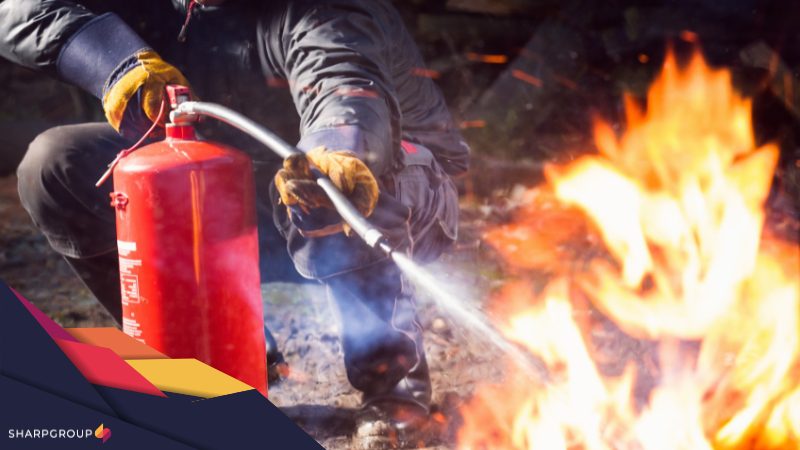
Water extinguishers are primarily used on Class A fires involving solid combustibles like wood, paper, and textiles. Some modern models include additives that make them suitable for limited Class B risks, replacing older foam extinguishers under updated standards. They work by cooling the fire and preventing re-ignition, offering an environmentally friendly and effective solution for most workplaces.
2. Carbon Dioxide (CO2) Fire Extinguishers
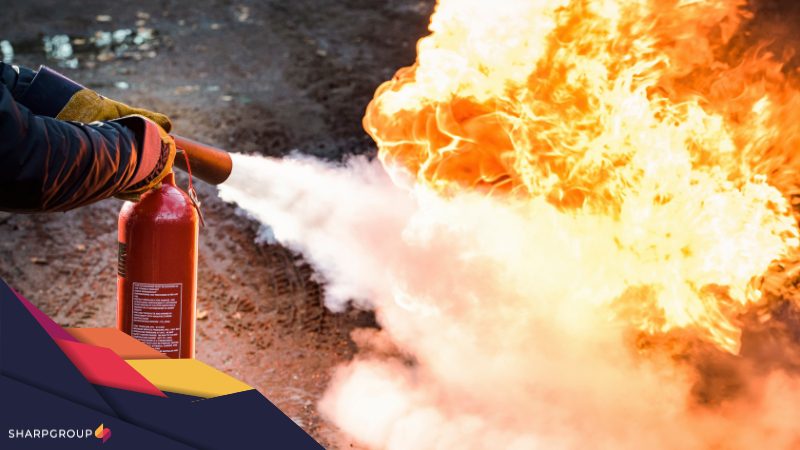
CO2 extinguishers are perfect for electrical fires and Class B fires involving flammable liquids. They work by displacing oxygen around the fire and are non-damaging to electronic equipment. This makes them ideal for offices and server rooms.
3. Dry Powder Fire Extinguishers
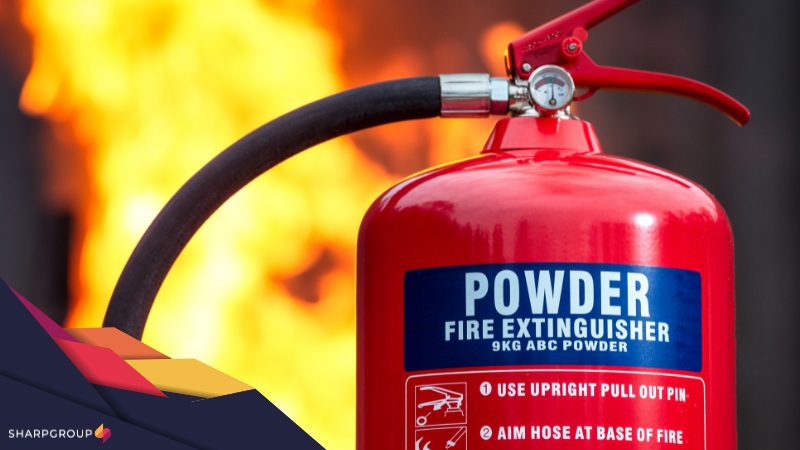
Dry powder extinguishers are versatile and can be used on Class A, B, and C fires. However, they can leave a residue that may damage sensitive equipment, so they should be used with caution indoors.
4. Wet Chemical Fire Extinguishers
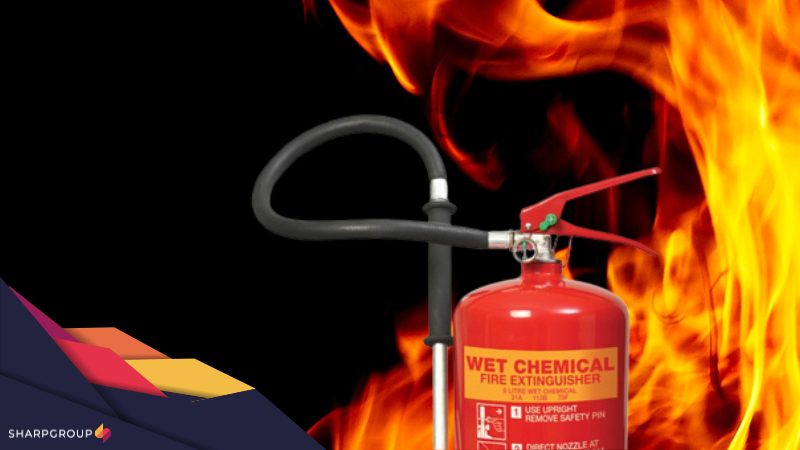
These are mainly used for Class F fires, which involve cooking oils and fats. They’re essential for kitchens in restaurants, canteens, and other food service areas.
Fire Extinguishers Types, Uses, Colours and Labelling
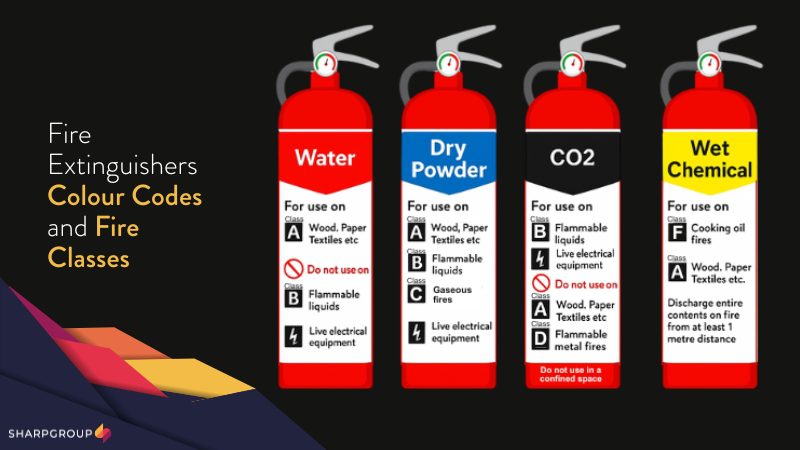
Knowing the types of fire extinguishers and their uses is vital for workplace safety. Always ensure extinguishers are positioned in accessible locations, clearly labelled, and maintained regularly. Conduct a thorough risk assessment. This helps identify the most suitable fire extinguisher types for each area of your premises. More guidance can be found on Gov.ie and HSA.ie.
Fire extinguishers types are colour-coded to indicate their contents and suitable use. Familiarise yourself with fire extinguisher colours. This helps ensure you select the correct one in an emergency. Class A fires are the most common type, but as you inspect your premises, you should be able to spot areas where other types of fires could potentially occur.
Red Label Fire Extinguisher: Water
- Class A Fire – involves solid materials such as wood, paper or textiles.
- Some modern water extinguishers with additives can also be effective on limited Class B Fires – involving flammable liquids such as petrol, diesel, or oils, replacing the traditional foam extinguisher.
Blue Label Fire Extinguisher: Dry Powder
- Class A Fire – involves solid materials such as wood, paper or textiles.
- Class B Fire – involves flammable liquids such as petrol, diesel or oils.
- Class C Fire – involves gases.
- Electrical Fire – involves live electrical equipment
Cream Label Fire Extinguisher: Foam
- Class A Fire – involves solid materials such as wood, paper or textiles.
- Class B Fire – involves flammable liquids such as petrol, diesel or oils.
Black Label Fire Extinguisher: Carbon Dioxide (CO2)
- Class B Fire – involves flammable liquids such as petrol, diesel or oils.
- Electrical Fire – involves live electrical equipment
Yellow Label Fire Extinguisher: Wet Chemical
- Class A Fire – involves solid materials such as wood, paper or textiles.
- Class F Fire – involves cooking oils such as in deep fryers.
Placement of Fire Extinguishers
Correct placement of fire extinguishers is crucial for safety and compliance. Extinguishers should be installed near potential fire hazards. They should be at a height that is easily accessible and clearly visible, with unobstructed access. Regular signage can assist staff and visitors in quickly locating them during an emergency. In multi-storey buildings, extinguishers should be placed on every floor and near exit routes to ensure rapid response. Staff should also be made aware of their locations through induction and ongoing training.
Irish Fire Safety Regulations
All businesses and buildings in Ireland must comply with fire safety legislation. This includes conducting risk assessments, maintaining fire detection systems, and implementing emergency procedures. Fire extinguishers must meet national standards and be regularly inspected by certified professionals. Maintaining records of inspections, maintenance, and staff training is essential for compliance. Detailed guidance is available in the Fire Safety Guide for Building Owners and Operators.
- Fire extinguishers should be positioned in easily accessible locations.
- Each extinguisher must be clearly labelled with its type and class.
- Regular inspections and maintenance should be carried out at least once a year.
- Every 3 years, extinguishers should be fully discharged and recharged.
How to Use a Fire Extinguisher
Knowing how to use a fire extinguisher correctly can make a life-saving difference. Follow the PASS method:
- Pull the pin to break the tamper seal.
- Aim the nozzle at the base of the fire.
- Squeeze the handle to release the extinguishing agent.
- Sweep the nozzle from side to side until the fire is out.
Always ensure you have a clear escape route and never attempt to fight a fire that is spreading too quickly. To increase safety, staff should receive certified Fire Safety Training. This can include hands-on practice with different fire extinguisher types. At Sharp Group, we provide fire training courses tailored to business needs. Employees gain the confidence and skills needed to respond effectively in an emergency.
Fire Alarm Integration
A fire extinguisher is most effective when paired with a properly maintained fire alarm system. Alarms provide early warning, giving occupants time to evacuate safely. They also allow emergency services to respond quickly. Combine fire alarm systems with the right types of fire extinguisher. Fire alarms and a fire suppression system work together to detect and control fires before they spread. This ensures a comprehensive approach to fire safety.
Choosing the Right Type of Fire Extinguishers
Selecting the correct types of fire extinguishers for your premises depends on the risks present. Conduct a risk assessment to determine the types of fire that could occur and match them with the appropriate extinguisher. Consider the environment, potential hazards, and ease of access for staff. Regular reviews of your fire safety plan help keep your workplace prepared. For detailed guidance, consult the Fire Safety Guide for Building Owners and Operators.
Maintenance and Training
Regular maintenance is crucial. Fire extinguishers should be checked at least annually by a certified professional. Staff should also be trained in the correct use of different fire extinguisher types. This includes practical drills to ensure confidence in an emergency. Training ensures employees know where extinguishers are located and how to use them effectively. It also teaches them how to respond safely in an emergency. More information is available on Citizens Information.
Understanding fire extinguishers is fundamental to any fire safety plan. It’s also important to know their correct use, placement, and maintenance. Choosing the right extinguisher, integrating a fire alarm system, and providing training are essential. Together, these comprehensive fire safety measures save lives and protect property.
Ensure your business is prepared with well-maintained fire extinguishers and proper placement. Professional training helps keep your team ready in an emergency. Explore our website to learn more about our Fire Safety Solutions and how we can help safeguard your premises.